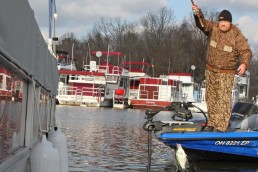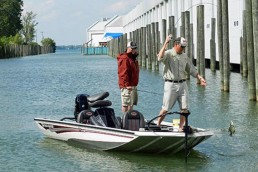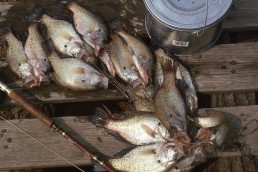Corking Docks for Shallow-water Spring Crappies
SHARE THIS POST
Everyone enjoys when the crappies move up into the shallow waters around the bank. Crappie season is a good time to have fast action. However, there is a shallow-water pattern that lasts longer and has proven to be a prime tactic for Russ Bailey. Bailey is a former tournament fisherman, guide and now host of Brushpile Crappie TV. This Ohio fisherman has mastered shallow-water tactics around docks and marinas and says most of the MidWest Outdoors region offers opportunities for this tactic.
What’s corking?
Corking is a jig/float combo used to pitch to potential crappie spots. It’s not usually a cast or shooting, but rather a pitching, to give maximum control of the bait. Since the target may be only six inches wide between a dock walkway and a pontoon boat, accuracy is important.
Bailey uses a tiny fly-fishing float along with a small jig—a 1/32 or 1/48-ounce. The mood of the crappies often requires a micro presentation. He uses his signature series B’n’M 10.5-foot pole and 6-pound-test line.
The technique
“In the cold months and then into the spring, I’ll be using a 10.5-foot pole and a flipping technique,” says Bailey. “It’s all about picking out your targets and flipping your wrist to put the bait where you want it. Just work the jig slowly under a cork. Once you figure out the depth, then you can set it and work the bait as slowly as you want.
“It’s almost a combination of casting and vertical jigging. You’re flipping it out like a short cast and then letting it set still like vertical jigging. With a Slip-cork, you can fish as deep as you want. What I do is concentrate on shallow lakes like Buckeye and St. Mary’s, but it usually works anywhere in the north. As long as you don’t have ice, the fish will stay in the shallows. At those lakes, the depth is often 2 to 5 feet. Some lakes where the fish are deeper, you can use a slip-cork to reach them.”
Slow water success
Bailey says many people are surprised this is a great winter method along with being a good springtime tactic. He says that the colder the water, the slower you’ll need to move your bait. Bites may be just a whisper of movement or they might nail it. The bite is often a factor of the water conditions.
“I use high-visibility, 6-pound-test line. Ten years ago, I wouldn’t use high-vis. Now that I’ve used it, I haven’t noticed a difference in the bite. And, with my vision now, hi-vis makes it easier to see the line. I catch more fish because I can see the bites.”
Are you enjoying this post?
You can be among the first to get the latest info on where to go, what to use and how to use it!
His jighead is not only small, but he prefers a plain lead head instead of a painted one when fishing shallow. He pegs his float to keep shallow depths but will use it as a slip-float when going deeper.
Tips
Bailey says to take your time working the jig. Cast and pop it a couple of times. Under a cork, it’ll jump a little and get the attention of the fish.
Flipping/corking can work great in the spring but also in the summer when the fish are using the shade.
“If I have to go 2 feet deep or more with my float,” says Bailey, “I set the hook hard like a bass fisherman. The angle of the line caused by the float, along with the long pole, requires to get the slack line out and then get the hook point into the fish.”
He says to not get hung up on jig colors. They can change from day to day. Try a few different shades to see which they prefer. The general rule is darker shades on overcast days and lighter shades on sunny days.
One of his last, but important, tips is to use scent. “I may not worry about it if the fish are biting. But, when they are negative or neutral, scent attractant can make a huge difference in the number of fish you catch. There are many good scents, but I’ve found nothing that works better than Berkley Crappie Nibbles. They really work.”
MWO
SHARE THIS POST
Did you enjoy this post?
You can be among the first to get the latest info on where to go, what to use and how to use it!
Tim Huffman
Tim Huffman specializes in crappie fishing, is editor for two crappie magazines, as well as writing for several others. In 2018, he published his sixth book, Limiting Out for Crappie, available at Amazon. His first article appeared in MidWest Outdoors in 1988.



